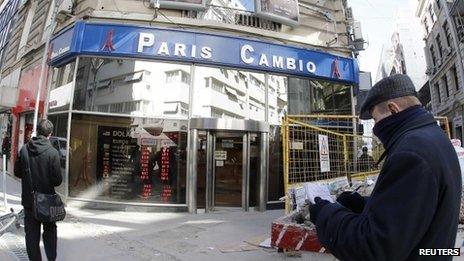Argentine peso suffers steepest fall since 2002 crisis
- Published

Argentina's currency, the peso, has seen its sharpest one-day fall since the country's 2002 financial crisis.
The peso fell 11% to stand at an official rate of eight pesos to the dollar. Unofficially, the rate is 13 pesos to the dollar.
The central bank had been acting to support the waning currency but this week all but gave that up.
Investors have lost confidence in the country. Despite efforts to support the economy, inflation has soared to 25%.
The official inflation rate is lower, but government data is not seen as entirely credible by those in the country nor the wider investment community.
This year, inflation is expected to top 30%.
That erodes confidence in the peso, prompting investors to put their money into US dollars rather than the sinking domestic currency.
Restrictions
Under the presidency of Cristina Fernandez de Kirchner, Argentina has introduced a number of restrictions on transactions with foreign currency.
This week it even introduced new restrictions on online shopping as part of increasingly desperate efforts to stop foreign currency reserves from falling any further.
Anyone buying items through international websites must sign a declaration and produce it at a customs office, where the packages have to be collected.
The government now limits tax-free purchases to two a year.
Argentina's reserves of hard currency dropped by 30% last year, making support for the peso increasingly unaffordable.
In 2002, millions of Argentines saw their incomes and living standards collapse amid a crisis that included a government default on international debts and 41% inflation.
- Published22 January 2014
- Published25 October 2013
- Published13 December 2012